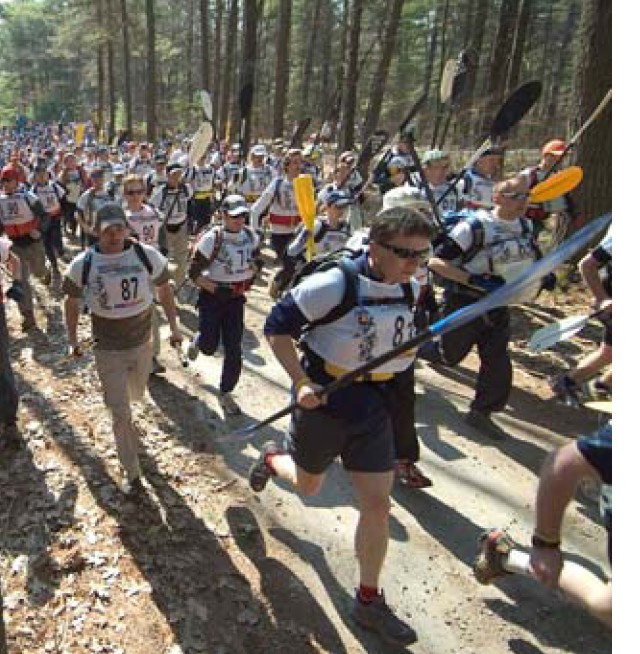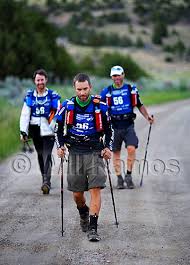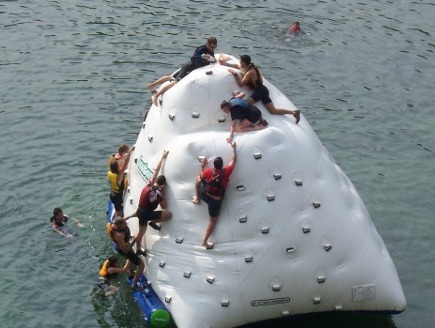Adventure Racing Definition
Adventure racing (also called expedition racing) is a combination of two or more endurance disciplines, including orienteering (if an orienteering map is used) and/or navigation (when non-orienteering maps are used), cross-country running, mountain biking, paddling and climbing and related rope skills. An expedition event can span ten days or more while sprints can be completed in a matter of hours. There is typically no suspension of the clock during races, irrespective of length; elapsed competition time runs concurrently with real time, and competitors must choose if or when to rest.
Adventure racing historically required teams to be of a specified size and to include both men and women, but many races no longer restrict team size and include single-sex divisions. Some also include age-based categories.
The roots of adventure racing are deep and people debate the origin of the modern adventure race. Some point to the two-day Karrimor International Mountain Marathon, first held in 1968 as the birth of modern adventure racing. The Karrimor Marathon required two-person teams to traverse mountainous terrain while carrying all the supplies required to support themselves through the double-length marathon run.
In 1980, the Alpine Ironman was held in New Zealand. Individual competitors ran, paddled and skied to a distant finish line. Later that year, the Alpine Ironman's creator, Robin Judkins launched the better-known Coast to Coast race, which involved most of the elements of modern adventure racing: trail running, cycling and paddling. Independently, a North American race, the Alaska Mountain Wilderness Classic debuted in 1982 and involved six days of unsupported wilderness racing (carry all food and equipment, no roads, no support) over a 150-mile course. It continues today, changing courses every 3 years.
In 1989, the modern era of adventure racing had clearly arrived with Gerald Fusil's launch of the Raid Gauloises in New Zealand. Inspired by the Paris-Dakar Rally, Fusil envisioned an expanded expedition-style race in which competitors would rely on their own strength and abilities to traverse great and challenging terrain. The race included all the modern elements of adventure racing, including mixed-gender teams competing in a multi-day 400+ mile race. Building on Fusil's concept, the inaugural Southern Traverse was held in 1991.
In the early-90's, Mark Burnett read an L.A. Times article about Raid Gauloises and was inspired to not only take the race to the USA, but to promote the race as a major televised sporting event. After purchasing the rights from Gerald Fusil, Burnett launched the first "Eco-Challenge" race in 1995. Burnett promoted his event with Emmy-award winning films (tapping the talent of Mike Sears to produce the films for the first two events). The Eco-Challenge was last held in 2002. With the Eco-Challenge also came the name "adventure race", a phrase coined by journalist and author Martin Dugard, to describe the class of races embodied by the Raid and Eco-Challenge.
In 2001, the inaugural World Championships were held in Switzerland with Team Nokia Adventure crossing the finishing line first. The concept of a world championship lay dormant until it was revived in 2004, with Canada's Raid the North Extreme serving as the AR World Championship event in Newfoundland & Labrador. The Adventure Racing World Series and its penultimate event, the AR World Championships have been held every year since. The 2013 World Championships will be the Costa Rica Adventure Racing in Costa Rica.
In 2002, the first major expedition length race to be held exclusively in the United States was launched. Primal Quest has become the premier U.S. expedition race, being held each year since its launch. In 2004, the death of veteran racer Nigel Aylott over-shadowed the race, and raised debates about the nature of Primal Quest and adventure racing.
In 2004, professional geologist Stjepan Pavicic organized the first Patagonian Expedition Race at the bottom tip of the American continent, in the Chilean Tierra del Fuego. Truly demanding routes through rough terrain of often more than 600 km soon made it be known as “the last wild race”.
In 2012, Commander Forer of the Royal Navy organized the first Sea-land navigation discipline race The Solent Amphibious Challenge. The race demanded the competitors to split up between sailing, running, and cycling in parts of the race and rendezvous at the end and sail the yacht to the finish line.




















Adventure racing (also called expedition racing) is a combination of two or more endurance disciplines, including orienteering (if an orienteering map is used) and/or navigation (when non-orienteering maps are used), cross-country running, mountain biking, paddling and climbing and related rope skills. An expedition event can span ten days or more while sprints can be completed in a matter of hours. There is typically no suspension of the clock during races, irrespective of length; elapsed competition time runs concurrently with real time, and competitors must choose if or when to rest.
Adventure racing historically required teams to be of a specified size and to include both men and women, but many races no longer restrict team size and include single-sex divisions. Some also include age-based categories.
The roots of adventure racing are deep and people debate the origin of the modern adventure race. Some point to the two-day Karrimor International Mountain Marathon, first held in 1968 as the birth of modern adventure racing. The Karrimor Marathon required two-person teams to traverse mountainous terrain while carrying all the supplies required to support themselves through the double-length marathon run.
In 1980, the Alpine Ironman was held in New Zealand. Individual competitors ran, paddled and skied to a distant finish line. Later that year, the Alpine Ironman's creator, Robin Judkins launched the better-known Coast to Coast race, which involved most of the elements of modern adventure racing: trail running, cycling and paddling. Independently, a North American race, the Alaska Mountain Wilderness Classic debuted in 1982 and involved six days of unsupported wilderness racing (carry all food and equipment, no roads, no support) over a 150-mile course. It continues today, changing courses every 3 years.
In 1989, the modern era of adventure racing had clearly arrived with Gerald Fusil's launch of the Raid Gauloises in New Zealand. Inspired by the Paris-Dakar Rally, Fusil envisioned an expanded expedition-style race in which competitors would rely on their own strength and abilities to traverse great and challenging terrain. The race included all the modern elements of adventure racing, including mixed-gender teams competing in a multi-day 400+ mile race. Building on Fusil's concept, the inaugural Southern Traverse was held in 1991.
In the early-90's, Mark Burnett read an L.A. Times article about Raid Gauloises and was inspired to not only take the race to the USA, but to promote the race as a major televised sporting event. After purchasing the rights from Gerald Fusil, Burnett launched the first "Eco-Challenge" race in 1995. Burnett promoted his event with Emmy-award winning films (tapping the talent of Mike Sears to produce the films for the first two events). The Eco-Challenge was last held in 2002. With the Eco-Challenge also came the name "adventure race", a phrase coined by journalist and author Martin Dugard, to describe the class of races embodied by the Raid and Eco-Challenge.
In 2001, the inaugural World Championships were held in Switzerland with Team Nokia Adventure crossing the finishing line first. The concept of a world championship lay dormant until it was revived in 2004, with Canada's Raid the North Extreme serving as the AR World Championship event in Newfoundland & Labrador. The Adventure Racing World Series and its penultimate event, the AR World Championships have been held every year since. The 2013 World Championships will be the Costa Rica Adventure Racing in Costa Rica.
In 2002, the first major expedition length race to be held exclusively in the United States was launched. Primal Quest has become the premier U.S. expedition race, being held each year since its launch. In 2004, the death of veteran racer Nigel Aylott over-shadowed the race, and raised debates about the nature of Primal Quest and adventure racing.
In 2004, professional geologist Stjepan Pavicic organized the first Patagonian Expedition Race at the bottom tip of the American continent, in the Chilean Tierra del Fuego. Truly demanding routes through rough terrain of often more than 600 km soon made it be known as “the last wild race”.
In 2012, Commander Forer of the Royal Navy organized the first Sea-land navigation discipline race The Solent Amphibious Challenge. The race demanded the competitors to split up between sailing, running, and cycling in parts of the race and rendezvous at the end and sail the yacht to the finish line.
Adventure Racing

Adventure Racing

Adventure Racing

Adventure Racing

Adventure Racing
Adventure Racing

Adventure Racing

Adventure Racing

Adventure Racing

Adventure Racing

Adventure Racing

Adventure Racing

Adventure Racing

Adventure Racing

Adventure Racing

Adventure Racing

Adventure Racing

Adventure Racing

Adventure Racing

Adventure Racing

No comments:
Post a Comment